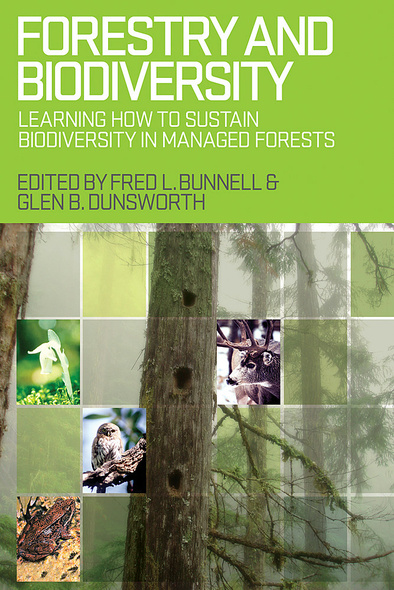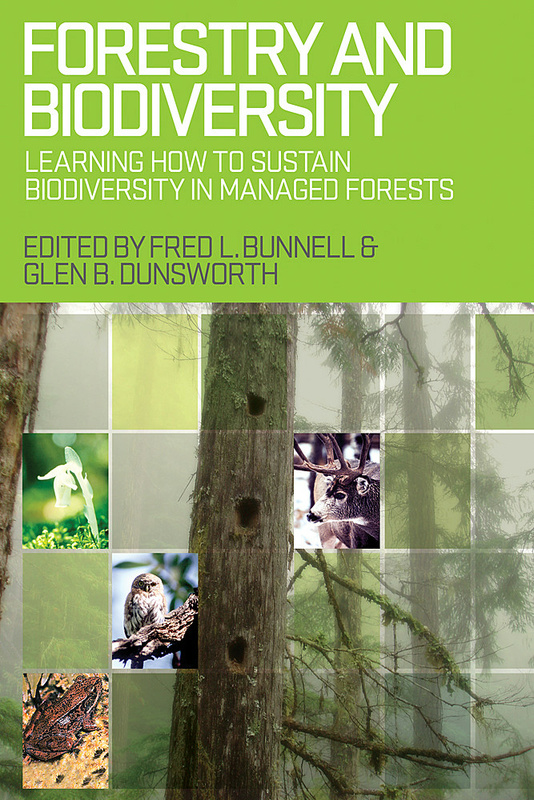
Forestry and Biodiversity
Learning How to Sustain Biodiversity in Managed Forests
Sustainable management is a problem for countries that depend on natural resources. Forests contain most of the world’s biodiversity and offer significant renewable resources with a potentially small ecological and carbon footprint. Yet the global demand for forest products has increased while the need to conserve biodiversity and endangered species has become more urgent and challenging.
Sustainable management in the forestry sector is complicated by the size and slow growth of commercial forests. Forestry and Biodiversity makes the case for adaptive management – a structured approach to learning by doing – to sustain biodiversity in managed forests. It draws on the theory and principles of conservation biology and forest ecology and illustrates them, and the challenges they present, through a practical, real-world study of a 1.1 million hectare commercial operation in a coastal temperate rainforest. The authors present the results honestly – not everything worked as intended – the problems they encountered suggest where the boundaries of science stop and social choices must be made.
Forestry and Biodiversity describes an innovate program for sustaining biodiversity in managed forests that will be of interest to those who plan, or hope to influence, forest practices and to those who are concerned with wildlife, climate change, and the environment.
This book is an essential read and reference for all forest stakeholders who are committed to integrated management of forests for sustained economic, environmental, and cultural values. So much written about this subject is theoretical, but this book shares major lessons from a large-scale real-world effort to implement such management and to assess its effectiveness.
There is a vast literature on ecologically sustainable forest management. But there are precious few scientifically defensible examples of it. This book is truly a rare gem that does exactly that -- provides a well-written and scientifically well argued case for how ecologically sustainable forest management should be done. The work described in this book sets a very high benchmark for others to reach. I highly recommend this volume to any forest ecologist, forest manager, or forest policy maker.
Fred L. Bunnell is a professor emeritus of forestry and conservation biology at the University of British Columbia. Glen B. Dunsworth is a forest ecology and conservation biology consultant.
List of Illustrations
Preface
Acknowledgments
Part 1: Introduction
1 The Problem / Fred L. Bunnell, Glen B. Dunsworth, David J. Huggard, and Laurie L. Kremsater
1.1 "Wicked" Problems
1.2 Expanding and Competing Values
1.3 Special Difficulties in Forests
1.4 Adaptive Management
1.5 Bounding the Book: What It Is and Is Not
1.6 Summary
2 The Example / Fred L. Bunnell, William J. Beese, and Glen B. Dunsworth
2.1 Physical and Ecological Setting
2.1.1 Physical Landscape
2.1.2 Climate, Vegetation, and Fauna
2.2 Social and Historical Contexts
2.3 New Planning and Practices
2.3.1 Planning
2.3.2 Practices
2.4 Structures to Make It Work
2.5 Monitoring
2.6 Summary
3 The Approach / Fred L. Bunnell and Glen B. Dunsworth
3.1 Managers’ Questions
3.2 Establishing Objectives and Measures of Success
3.2.1 Defining Biological Diversity
3.2.2 A Criterion and Indicators of Success
3.3 Deciding on Actions
3.4 Evaluating Success
3.4.1 Bounding the Problem
3.4.2 The Major Questions
3.4.3 Kinds of Monitoring and Adaptive Management
3.4.4 Creating Structured Learning
3.5 Linking Findings to Actions
3.6 Summary
4 Implementing the Approach / Fred L. Bunnell, William J. Beese, and Glen B. Dunsworth
4.1 Change in Midstream
4.2 Progress in Adopting the Approach
4.2.1 Implementing Planning
4.2.2 Implementing Variable Retention
4.3 Assessing the Outcomes of Guidelines
4.3.1 Biological Legacies
4.3.2 Forest Influence
4.3.3 Amount of Retention
4.3.4 Forest Stewardship
4.3.5 Requisite Variety
4.4 Lessons from Implementation Monitoring
4.5 Summary
Part 2: The Indicators
5 Effectiveness Monitoring: An Introduction / Fred L. Bunnell, David J. Huggard, and Glen B. Dunsworth
5.1 Context
5.2 How Do We Ask Our Questions?
5.3 What Would We Do with the Data if We Had Them?
5.4 How Do We Discern What Is Better?
5.5 Where Does the Answer Apply?
5.6 The Role of Pilot Studies
5.7 Summary
6 Ecosystem Representation: Sustaining Poorly Known Species and Functions / David J. Huggard and Laurie L. Kremsater
6.1 Rationale
6.2 What to Monitor
6.2.1 Amount of Non-Harvestable or Lightly Managed Area
6.2.2 Ecosystem Representation
6.2.3 Size of Non-Harvestable Patches and Geographic Distribution
6.2.4 Edge and Interior
6.2.5 Special Ecosystems and Productivity
6.2.6 Other Indices of Spatial Pattern
6.2.7 Natural Disturbances and Stand Age Distribution
6.2.8 Responsibility and Regional Protected Areas
6.3 How to Monitor
6.4 Anticipated Feedback to Management
6.5 Summary
7 Learning from Ecosystem Representation / David J. Huggard, Laurie L. Kremsater, and Glen B. Dunsworth
7.1 Context
7.2 Methods
7.2.1 Ecosystem Representation
7.2.2 Edge/Interior and Patch Size
7.2.3 Other Land Use Designations Emphasizing Conservation
7.2.4 Responsibility and Protected Areas
7.3 Results
7.3.1 Responsibility and Protected Areas
7.3.2 Representation of Variants in the Non-Harvestable Land Base
7.3.3 Representation of Site Series
7.3.4 Edge/Interior and Other Spatial Aspects
7.3.5 Representation in Other Conservation Designations
7.4 Discussion
7.4.1 Limitations of Analysis
7.4.2 Management Priorities: Under-Represented Dry Variants
7.4.3 Management Priorities: Edge Effects
7.4.4 Focusing Finer-Filter Monitoring
7.5 Summary
8 Sustaining Forested Habitat / David J. Huggard, Fred L. Bunnell, and Laurie L. Kremsater
8.1 Rationale
8.1.1 Habitat Elements in Stands
8.l.2 Habitat Structure in Stands
8.1.3 Landscape Features
8.2 What to Monitor
8.2.1 Standard Habitat Elements and Their Attributes
8.2.2 Integrative Habitat Variables
8.2.3 Process Variables for Long-Term Habitat Projections
8.2.4 Landscape Features
8.2.5 Hypothetical Species as Landscape Indices
8.3 How to Monitor
8.3.1 Standard Habitat Elements and Their Attributes
8.3.2 Integrative Habitat Variables (Habitat Structures)
8.3.3 Process Variables for Long-Term Habitat Projections
8.3.4 Landscape Features
8.3.5 Hypothetical Species for Landscape Evaluation
8.4 Anticipated Feedback to Management
8.5 Summary
9 Learning from Habitat Elements / David J. Huggard, Jeff Sandford, and Laurie L. Kremsater
9.1 Context
9.2 Methods
9.2.1 Field Methods
9.2.2 Subsampling Design
9.2.3 Study Design
9.2.4 Approach to Summaries
9.3 Results and Implications
9.3.1 Expected Precision
9.3.2 Comparison among Retention Types
9.3.3 Comparison of Retention Patches with Uncut Benchmarks
9.3.4 Relationships of Habitat Elements with Percent Retention
9.3.5 Edge Effects
9.3.6 Comparison of Patch Anchor Types
9.3.7 Operational Progress
9.4 General Discussion
9.5 Summary
10 Sustaining Forest-Dwelling Species / Laurie L. Kremsater and Fred L. Bunnell
10.1 Rationale
10.2 What to Monitor? An Overview
10.3 What to Monitor: Vascular Plants
10.3.1 Factors Influencing Monitoring: Vascular Plants
10.3.2 How to Monitor: Vascular Plants
10.3.3 Links to Management: Vascular Plants
10.4 What to Monitor: Bryophytes
10.4.1 Factors Influencing Monitoring: Bryophytes
10.4.2 How to Monitor: Bryophytes
10.4.3 Links to Management: Bryophytes
10.5 What to Monitor: Lichens
10.5.1 Factors Influencing Monitoring: Lichens
10.5.2 How to Monitor: Lichens
10.5.3 Links to Management: Lichens
10.6 What to Monitor: Fungi
10.6.1 Factors Influencing Monitoring: Fungi
10.6.2 How to Monitor: Fungi
10.6.3 Links to Management: Fungi
10.7 What to Monitor: Invertebrates
10.7.1 Factors Influencing Monitoring: Invertebrates
10.7.2 How to Monitor: Invertebrates
10.7.3 Links to Management: Invertebrates
10.8 What to Monitor: Vertebrates
10.8.1 Factors Influencing Monitoring: Vertebrates
10.8.2 What to Monitor: Vertebrates
10.8.3 Links to Management: Vertebrates
10.9 Overall Feedback to Management
10.10 Summary
11 Learning from Organisms / David J. Huggard and Laurie L. Kremsater
11.1 Context
11.2 Intended Roles of the Pilot Study Phase
11.2.1 Assess Sensitivity to Forest Practices
11.2.2 Define Ecological Strata
11.2.3 Define Appropriate Sampling Methods
11.2.4 Guide Optimization of Sampling
11.2.5 Illustrate Ways to Generalize
11.2.6 Summary of the Pilot Phase
11.3 Individual Monitoring Projects
11.3.1 Breeding Bird Surveys
11.3.2 Songbirds
11.3.3 Owls
11.3.4 Red Squirrels
11.3.5 Carabid (Ground) Beetles
11.3.6 Gastropods
11.3.7 Bryophytes and Vascular Plants
11.3.8 Epiphytic Lichens
11.3.9 Ectomycorrhizal Fungi
11.3.10 Aquatic-Breeding Amphibians
11.4 Summary
Part 3: Summary
12 Designing a Monitoring Program / David J. Huggard, Laurie L. Kremsater, and Fred L. Bunnell
12.1 Context
12.2 How to Ask Questions
12.2.1 Comparisons and Mechanisms
12.2.2 Types of Comparisons
12.3 Stand-Level Comparisons
12.3.1 Very High-Priority Comparisons
12.3.2 High-Priority Comparisons
12.3.3 Moderate-Priority Comparisons
12.3.4 Low-Priority Comparisons
12.3.5 Summary of Comparisons
12.4 Selecting Indicator Variables
12.5 Matching Indicators with Comparisons
12.6 Answering Questions Well
12.6.1 Operational versus Experimental Comparisons
12.6.2 Blocking Factors
12.6.3 Pre-Treatment Measurement
12.7 Monitoring over Larger Areas
12.7.1 Indicator 1: Representation of Ecosystem Types in Non-Harvestable Areas
12.7.2 Indicator 2: Stand and Landscape Features
12.7.3 Indicator 3: Organisms
12.7.4 Other Possible Ecological Variables for Broad-Scale Monitoring
12.8 The Role of Models
12.8.1 General Modelling Approach
12.8.2 Specific Forms of Modelling
12.8.3 Implications of Incorporating Mechanisms
12.9 Summary
13 Summary: Progress and Lessons Learned / Fred L. Bunnell, David J. Huggard, and Laurie L. Kremsater
13.1 Context
13.2 Progress
13.3 Lessons Learned
13.3.1 Organizational Structure
13.3.2 Design
13.3.3 Feedback
13.4 Summary Thoughts
Appendices
Notes
Glossary
Literature Cited
List of Contributors
Index





